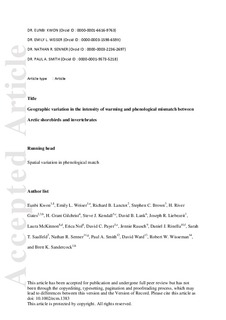| dc.description.abstract | Responses to climate change can vary across functional groups and trophic levels, leading to a temporal decoupling of trophic interactions or “phenological mismatches.” Despite a growing number of single-species studies that identified phenological mismatches as a nearly universal consequence of climate change, we have a limited understanding of the spatial variation in the intensity of this phenomenon and what influences this variation. In this study, we tested for geographic patterns in phenological mismatches between six species of shorebirds and their invertebrate prey at 10 sites spread across ~13° latitude and ~84° longitude in the Arctic over three years. At each site, we quantified the phenological mismatch between shorebirds and their invertebrate prey at (1) an individual-nest level, as the difference in days between the seasonal peak in food and the peak demand by chicks, and (2) a population level, as the overlapped area under fitted curves for total daily biomass of invertebrates and dates of the peak demand by chicks. We tested whether the intensity of past climatic change observed at each site corresponded with the extent of phenological mismatch and used structural equation modeling to test for causal relationships among (1) environmental factors, including geographic location and current climatic conditions, (2) the timing of invertebrate emergence and the breeding phenology of shorebirds, and (3) the phenological mismatch between the two trophic levels. The extent of phenological mismatch varied more among different sites than among different species within each site. A greater extent of phenological mismatch at both the individual-nest and population levels coincided with changes in the timing of snowmelt as well as the potential dissociation of longterm snow phenology from changes in temperature. The timing of snowmelt also affected the shape of the food and demand curves, which determined the extent of phenological mismatch at the population level. Finally, we found larger mismatches at more easterly longitudes, which may be affecting the population dynamics of shorebirds, as two of our study species show regional population declines in only the eastern part of their range. This suggests that phenological mismatches may be resulting in demographic consequences for Arctic-nesting birds. Arctic invertebrates; phenology; spatial gradient; structural equation modeling; timing of breeding; trophic interactions. | nb_NO |
